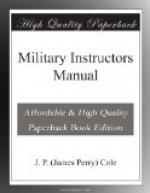8. The duties of the relieved
commander are:
(1) To turn over his sector thoroughly policed
and in good
condition as regards its construction
and the new work,
if any, in progress.
(2) To turn over his supplies in good condition
and fully
accounted for.
(3) After reporting the relief, to march
his men back to
billets as promptly and secretly as possible,
in column
of files, platoon leaders in the rear
of their platoons,
a non-commissioned officer and guide
at the head of each.
(4) On the evening preceding relief, to send
his cooks back
to billets so that his men may be provided
with a hot
meal immediately on arrival.
D. If an attack occurs during the
march through the boyaux, to or
from relief, the company affected occupies the
nearest
defensive position and at once notifies its
battalion
commander. If an attack occurs during the
actual process of
relief, the senior officer present takes command.
II. The Stay in the Trenches.
A. THE FOUR OBJECTS OF A TRENCH COMMANDER:
1. Security of his sector. 2. Protection of his troops. 3. Constant and accurate observation. 4. A continuous offensive.
B. HIS PLAN OF DEFENSE:
1. General principles of defense: (a) Arrangement in depth. The most dependable defense is in prearranged counter attacks. The system of defense must react like a helical spring. (b) Tenacity of defense. 1. Each unit must be prepared to hold its post to the last extremity. 2. Orders to withdraw will never be obeyed unless unmistakably valid. 3. All ground lost must be retaken at once in counter attack by the unit which lost it. (c) Apportionment of responsibility. Each active segment must have a commander responsible for its defense, upkeep and sanitation, and the discipline and instruction of his men.
2. Basis:
(a) The plan of defense turned over by the preceding
commander.
This will usually suffice for the first
24 hours after
relief.
(b) General information of the enemy’s
lines, dispositions, and
intentions, based chiefly on aerial photographs.
C. ORGANIZATION OF DEFENSE:
1. Allocation of front. (The
front of an American battalion will
average about
1,000 yards.)
Diagrams:
A. The Regiment. B. The Battalion. C. The
Company. D.
The Platoon.
2. Distribution of effectives.
Determined chiefly by the terrain
and by 3.
3. Employment of the several
arms:
(a) Machine guns.
Crew of 8 men per gun. (Furnished by
detachments
of a machine gun company.) Located by the
infantry
commander, in concealed emplacements behind the
first
line, to deliver successive barrages from flanking
positions.
Effective range: up to 700 yards.
(b) Automatic




